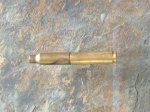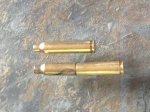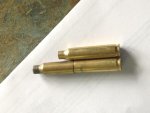Was shooting some test loads out of my 16" AR this morning and had an interesting event. I was shooting the first round of the powder charge, I believe it was 24.1gr (.2 under Ramshot's published max) and the LC brass split horizontally between the shoulder and case head. Luckily I didn't get any real gas thrown back at me or anything, but it slammed the next round into the piece of case left in the chamber. It actually helped, I was able to pry the live round and broken case out together off the live rounds rim. The load was 24.1gr TAC, LC brass, 69 SMK and CCI 450. The brass was full length sized with shoulder bumped back .005. Worked up from start load, noticed no pressure signs, primers weren't flattening or cratering and rifle was cycling smooth. The TAC did seem pretty dirty, cases were coming out with a good amount of soot.
So was this just a case of a metallurgic defect, or something I did wrong?
So was this just a case of a metallurgic defect, or something I did wrong?



